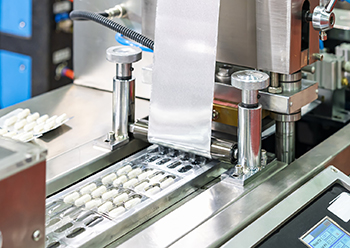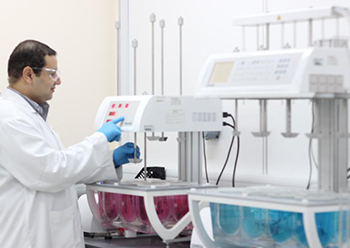

The Middle East and Africa region's pharamceuticals market is expected to post a compound annual growth rate (CAGR) of 7.5% over 2021–2026, faster than Europe and North America, says a report.
Against a background of rising inflationary pressure due to a surge in global commodity prices and supply chain disruptions, the IQVIA’s Market Prognosis forecast for the global pharmaceutical market has been adjusted upwards to 6.7% in 2022, and to a CAGR of 5.7% during the period 2021–2026.
The forecast five-year CAGR over 2021–2026 for total pharmaceutical sales across the five MEA markets is 7.5%, down from a CAGR of 8.5% over 2016–2021, says the Iqvia report authored by Shamsuzzaman Ansari Senior Insights Analyst.
Although the Covid-19 pandemic had a significant impact on sales growth of the MEA region, which slowed from 6.9% in 2019 to 0.6% in 2020, the region experienced a rebound in 2021 as healthcare provision normalised and patient footfall recovered.
Pharmaceutical market in the Middle East is projected grow exponentially and reach $60 billion by 2025, says another study. Within the Middle East, Saudi Arabia and the United Arab Emirates (UAE) are the largest markets for the industry.
The study reveals that Saudi Arabia’s pharmaceutical market is expected to be valued at $10.74 billion by 2023.
According to the whitepaper by Abu Dhabi’s ADQ, the UAE’s pharmaceutical market is expected to grow by 27% between 2021 and 2025, reaching a value of $4.7 billion. The number of manufacturing units in the country reached 23 in 2021, up from four in 2010, with 14 producing medicines, four manufacturing medical devices, and two focused on disinfectant solutions. There are now more than 2,500 medicines produced locally.
Out of the five key MEA countries (Saudi Arabia, Egypt, South Africa, United Arab Emirates and Algeria) covered by Iqvia's Market Prognosis, Egypt will witness the highest CAGR (11.9%) during the forecast period, mainly driven by price growth amidst high inflationary pressure, regulatory improvements under the new Egyptian Drug Authority (EDA) and the rollout of a comprehensive health insurance scheme. This will be followed by the UAE and Saudi Arabia, which will post CAGRs of 7.0% and 6.3%, respectively, during the prognosis period, the report said.
Revised visa policies in the last couple of years in the UAE are expected to trigger an increase in the expat population, contributing to growing demand for chronic disease medications. The UAE will also witness a sharp rise in the number of medical tourists from neighbouring countries seeking high quality treatments as economic growth rebounds and as private healthcare providers continue to invest in state-of-the-art facilities, it says.
Due to strong anticipated real GDP growth during 2022–2023, the pharmaceutical markets in Saudi Arabia and the UAE will have minimal impact from ongoing macroeconomic developments. On the other hand, Egypt will witness significant price growth over the short term for some pharmaceuticals in response to higher costs for importing active pharmaceutical ingredients (APIs) as a result of currency devaluation and high inflationary pressure.
LOCALISATION
MEA countries are seeking localisation to expand their industrial capacity, reduce dependency on imports from other countries and gain economic benefits. Pharmaceutical industry localisation is an important part of Saudi Arabia’s Vision 2030. During the tender process, the Local Content and Government Procurement Agency (LCGPA) plays a key role in promoting the government’s policy of localisation, providing incentives for companies to manufacture products in Saudi Arabia, says the report.
By 2024, companies that do not have regional headquarters in Saudi Arabia will not be allowed to participate in government tenders. As a result of this policy, pharmaceutical companies are transferring their MEA regional offices to Saudi Arabia.
Localisation also remains high on the government’s agenda in Egypt, South Africa, and Algeria. The governments in these countries are promoting import substitution through local manufacturing and technology transfer agreements. Multinationals are being encouraged to enter into partnerships/ collaborations with local partners to access price incentives and obtain earlier approvals for their products. Overseas companies that do not pursue such strategies will find the operating environment in these countries increasingly challenging. In Algeria, imports are not allowed for products that can be produced locally in sufficient quantities, while imports of other products are regulated by annual quotas.
CENTRALISED PROCUREMENT
To avoid shortages, provide greater transparency and secure the supply of quality-assured medicines at affordable prices, several countries in the MEA region have adopted centralised procurement mechanisms.
This procurement strategy was further expanded during the COVID-19 pandemic due to the widespread supply chain disruptions.
In Saudi Arabia, the National Unified Procurement Company for Medical Supplies (NUPCO) is the sole purchaser of medicines and medical devices on behalf of all public hospitals, and thus has a high negotiating power. In Egypt, a shift towards consolidated procurement began in the first half of 2020, with the launch of the Unified Procurement Authority (UPA).
Negotiations between pharmaceutical companies and the procurement authorities are price focused, preventing companies from varying prices for different public healthcare facilities, which adversely affects their profit margins. The increased scrutiny over prices is hampering an effective assessment of the benefits of the drugs. This may affect patients’ access to high value products during the forecast period. In South Africa, a national level tendering which is managed by the Treasury is limited mainly to anti-retroviral and tuberculosis drugs. However, as the NHI scheme develops, a wider selection of medicines will be subject to national tenders, the study says.
GENERICS AND BIOSIMILARS
Public as well as private payers across the region are taking steps to encourage the use of generics and biosimilars to contain pharmaceutical expenditure and generate savings.
In Saudi Arabia, generics are being dispensed under the Wasfaty program to ensure affordability for patients. Health insurance companies are also supporting generic uptake by limiting physician prescribing to generics. The UPA’s preference for low-cost medicines is driving the uptake of generics and biosimilars in Egypt. Further expansion of the generics market is anticipated in Egypt, driven by the rollout of the UHC scheme and localization policies.
The implementation of pro-generic policies, including reference pricing in Abu Dhabi and inclusion in formularies managed by the Abu Dhabi Health Services Company (SEHA), the Ministry of Health and Prevention (MOHAP) and DHA, will continue to drive up generic use across the UAE, it said.
Acceptance of biosimilars in the region has increased appreciably over recent years, and will continue to grow through the prognosis period, reflecting the desire of governments, as well as private insurers, to generate savings. Interest in their manufacture is also increasing among local companies. However, the lack of clear guidelines regarding the use of biosimilars in most MEA markets has hindered stronger market growth, Iqvia research said.
The growing use of generics and biosimilars will put downward pressure on average prices in the region, it added.


